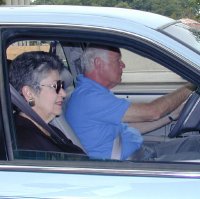Senior Driving in Alaska
 A man poses for a NHTSA driving ad |
 An elderly couple travels across country |
 A man waits at a red light |
Everyone ages differently and where some
people are perfectly capable of continuing to drive
in their seventies, eighties, and even beyond; many
elders, however, are at higher risk for on or off road
crashes. According to studies conducted by the National
Highway Traffic Safety Administration (NHTSA) senior
drivers are more likely to receive traffic citations
for failing to yield, turning improperly, and running
red lights and stop signs - an indication of decreased
driving ability. A person 65 or older who is involved
in a car crash is more likely to be seriously injured,
more likely to require hospitalization, and more likely
to die than younger people involved in the same crash.
In particular, fatal crash rates rise sharply after
a driver has reached the age of 70.
How should you prepare to start the conversation with an older driver? Here is helpful information provided by The Hartford Financial Services Group ![]() on how and when to help someone through this often difficult decision making process.
on how and when to help someone through this often difficult decision making process.
Organizations
- Alaska
AARP

- Alaska
Department of Health and Social Services (Senior
Services Division)

- AAA

- Senior
Corps

- SeniorDrivers.org

- AgeLab

Useful Articles and Statistics
- Senior
Citizen Driving: Warning Signs and Helping an Unsafe
Driver to Stop Driving

- Better
Options for Older Adults

- Mature
Driver Information from the Alaska DMV

- Alaska
DUI Advice

- 1994-2006 Pedestrian Fatalities by Age
 (79 KB)
(79 KB) - AAA Foundation - Senior Safety & Mobility
 (620 KB)
(620 KB) - When a Disoriented Senior Wants to Drive

- Good Morning America story "Mom and Dad, We Need to Talk"

The Driving Safety Cycle
PLAN: Before you begin driving, plan your route, make sure your car is properly prepared and make alternate transportation arrangements when appropriate.
SCAN: Pay close attention to what is happening all around you. Look and listen for situations that may require you to react quickly.
THINK: Consider how safety will be affected by what you have seen or heard.
DECIDE: Decide how to handle the situation so you feel in control.
ACT: Apply good judgement to eliminate unsafe acts and unsafe conditions.

Safety Topics
- DEC / DRE
- Distracted Driving
- Fatality Analysis Reporting System (FARS)
- Headlights
- Media Campaigns
- Occupant Protection
- DUI Information & Impaired Driving
- Senior Driving in Alaska
- Teen Driving in Alaska
- Traffic Records
